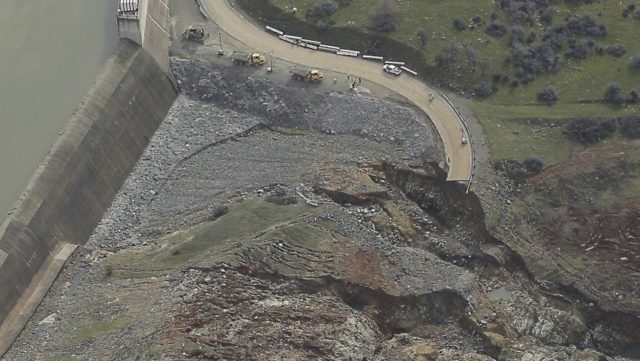Communities just downstream of California’s Lake Oroville dam would not receive adequate warning or time for evacuations if the 770-foot-tall dam itself — rather than its spillways — were to abruptly fail, the state water agency that operates the nation’s tallest dam repeatedly advised federal regulators a half-decade ago.
The state Department of Water Resources informed federal dam regulators that local emergency officials “do not believe there is enough time to perform evacuations in the communities immediately downstream of the dam during a sudden failure,” according to a Feb. 8, 2011, letter reviewed by The Associated Press.
Absent “significant” advance warning, emergency responders instead would likely withdraw to safer ground and prepare for victims, said the same letter by the Federal Energy Regulatory Commission, which oversees safety of hydroelectric dams, in a summary of the state’s conclusions.
The catastrophic scenario of a sudden breach at California’s second-largest water reservoir, outlined between 2010 and 2012 in online archives of federal dam regulators, is a different and far graver situation than the concern that prompted sudden evacuation orders Sunday for 188,000 downstream residents.
In an email Thursday, state water agency spokesman Ed Wilson said that despite the repeated back-and-forth correspondence by state and federal officials about reducing detection- and response time to allow for evacuations downstream in the event of Oroville dam’s sudden failure, the scenario was “hypothetical” and “not how dams typically fail in real life.”
Late Sunday afternoon, operators of the nearly half-century-old dam in California’s Sierra Nevada foothills became alarmed that the water cascading from the reservoir after a series of winter storms could roar uncontrolled down a rapidly eroding emergency spillway toward towns downstream. They ordered residents of parts of three counties to leave.
Despite the troubles with the dam’s flood-control spillways, authorities have stressed that they do not believe the dam itself is threatened. Sunday’s precautionary evacuation order was eased by mid-week to allow people to return to the 16,000-resident town of Oroville and other communities.
The federal-state discussion about the worst-case scenario over the years highlights steps that California’s water agency and others still should take to do more to improve warning and escape for people downstream, say local officials and a Florida-based evacuation expert.
Those measures include widening the entirety of a mixed two- and four-lane state highway leading away from Oroville and other communities and doing more to improve public-warning systems. The federal dam regulators also called for annual “public education…that describes what residents should do during an emergency” at the dam.
As it was, some families who leaped into their cars to flee on Sunday found themselves caught in traffic jams hours later in the path of potential danger.
“People were just panicking,” said Nancy Borsdorf of Oroville, who grabbed two Bibles and a Christian-music CD to take with her after friends phoned to urge her to go. “‘Get out of town, the dam is going to blow.'”
Many public officials and ordinary people rushed to help direct traffic or to settle the evacuees streaming into shelters. But evacuees also described seeing families abandoning cars, and even watching fistfights on gridlocked roads.
The federal government in recent years has made evacuation and emergency-response plans for major dams off-limit information for the public, for fear details could be exploited for terror attacks or hacking. California officials cited that reason this week in declining to release the latest emergency plans for the dam.
Wilson, the state Department of Water Resources spokesman, said authorities have implemented the reverse-911 automated warnings recommended by federal regulators, and also activated an emergency broadcast system locally. Residents confirmed the reverse-911 system worked Sunday.
With the arrival Thursday of a new wave of storms, and months left in the rainy season, state spokesperson Nancy Vogel said California now has drones, cameras and human lookouts watching the dam and its spillways.
Operators have been releasing torrents of water down the damaged main spillway to try to make sure the water does not pour over the emergency spillway as it did last weekend.
Even with round-the-clock efforts by dam operators, Oroville Mayor Linda Dahlmeier immediately began praying for those closer to the dam when she heard the first drops of rain hit the metal roof of her home Thursday.
“You just start bawling,” Dahlmeier said. “This is Mother Nature’s hand.”
Oroville used to have civil-defense sirens for emergencies, Dahlmeier thought, but funds for such public expenses have dwindled in the foothill counties. Neither she nor others recalled the annual safety briefings for the public that federal regulators urged of the state water agency.
“You know what the evacuation plan is? ‘Get the hell out of town!'” said Kevin Zeitler, a critic of the state water agency’s interactions with communities downstream of the dam.
Zeitler was staying put at his office in Oroville’s vulnerable downtown, but keeping his pickup truck out front fully packed.
Since the 1990s, Oroville and other communities in Butte County have asked the state for the $300 million it would take to widen the full route of a key highway out of the county from two lanes to four, said Jon Clark, head of the Butte County Association of Governments.
Unquestionably, that would have helped in the evacuations, Clark and others said.
For Butte County’s many low-income retirees and others unable to drive, Clark’s association got buses on the road Sunday to carry people to safety.
In a disaster as sudden as a major problem with a dam, authorities will have had warning signs telling them to increase their vigilance, even if that is just forecasts of storms coming, said John Renne, an urban-planning professor at Florida Atlantic University.
And the public can almost always be warned, even if it entails greater government investment in public-warning technology. “Minutes can save lives,” Renne said.
___
Associated Press writers Don Thompson in Sacramento and Tim Reiterman in San Francisco contributed to this report.

COMMENTS
Please let us know if you're having issues with commenting.